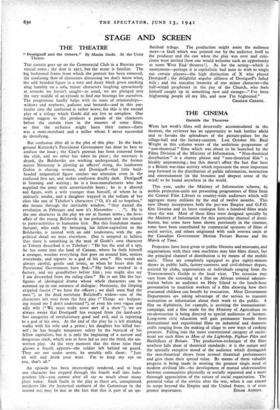THE CINEMA
Outside the Theatres
WITH last week's films still deservedly accommodated in the theatres, the reviewer has an opportunity to look further afield and to forsake the splendours of the picture-palace for the village-hall and the. factory-canteen. Last October Mr. Basil Wright in this column wrote of the ambitious programme of "non-theatrical " films which was about to be launched by the Films Division of the Ministry of Information. "Non-theatrical distribution " is a clumsy phrase and "non-theatrical film " is bleakly unpromising ; but this doesn't affect the fact that here is a British war-time activity which represents the most important step forward in the distribution of public information, instruction and entertainment (in the broadest and deepest sense of the word) to be found anywhere in the world.
This year, under the Ministry of Information scheme, 65 mobile projection-units are presenting programmes of films from the Central Film Library to country-wide audiences which will aggregate many millions by the end of twelve months. This new library incorporates both the pre-war Empire and G.P.O. film libraries and its latest catalogue lists a hundred films made since the war. Most of these films were designed specially by the Ministry of Information for this particular channel of distri- bution, but some have been shown previously in the cinemas, some have been contributed by commercial sponsors of films of social service, and others originated with such oversea units as the Canadian Government Motion Picture Bureau and the March of Time.
Projectors have been given to public libraries and museums, and organisations with their own machines may hire films direct, but the principal channel of distribution is by means of the mobile units. These are completely equipped to give eighty-minute shows in public halls, factory-canteens and civil-defence depots, assisted by clubs, organisations or individuals ranging from the Townswomen's Guilds to the local vicar. The occasion may vary from the screening of a film on African colonial adminis- tration before an audience on Holy Island to the lunch-hour presentation to munition workers of a film showing how their evacuated children can benefit by evacuation. Most Government Departments are taking advantage of the service to transmit instruction or information about their work to the public. A film on diphtheria, for example, is assisting the immunisation- campaign, and a film made for the Ministry of Agriculture on rat-destruction is being directed to special audiences of farmers. Long-term civic education will gain permanent benefit from instructional and expositional films on industrial and domestic crafts ranging from the making of silage to new ways of cooking potatoes. Falling into the more conventional category of excite- ment are such films as Men of the Lightship, Fighter Pilot and Battle fleets of Britain. The production-technique of the films nowhere falls short of theatrical standards : it is the nature and the specially receptive mood of the audience which distinguish the non-theatrical shows from normal theatrical performances and give them their special value. By means of them valuable progress is being made in meeting the greatest single need of modern civilised life—the development of mutual understanding between communities physically or socially separated and a more thorough appreciation of the nature of social organisation. The potential value of the service after the war, when it can extend its scope beyond the Empire and the United States, is of even


























 Previous page
Previous page